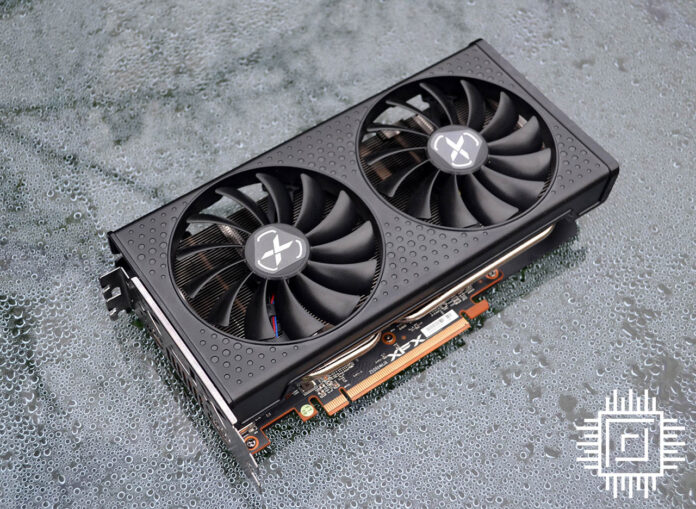It is customary for AMD and Nvidia to release the best graphics cards and then follow them up, in sequence, with models incrementally lower down the range. This waterfall strategy ensures enthusiasts are steered towards high-margin parts first, with the mainstream market providing profit through volume.
AMD uses this top-first philosophy for RDNA 2-powered Radeon RX 6000 Series GPUs. The boss cards arrived in November 2020 and have been followed by the lower echelons ever since.
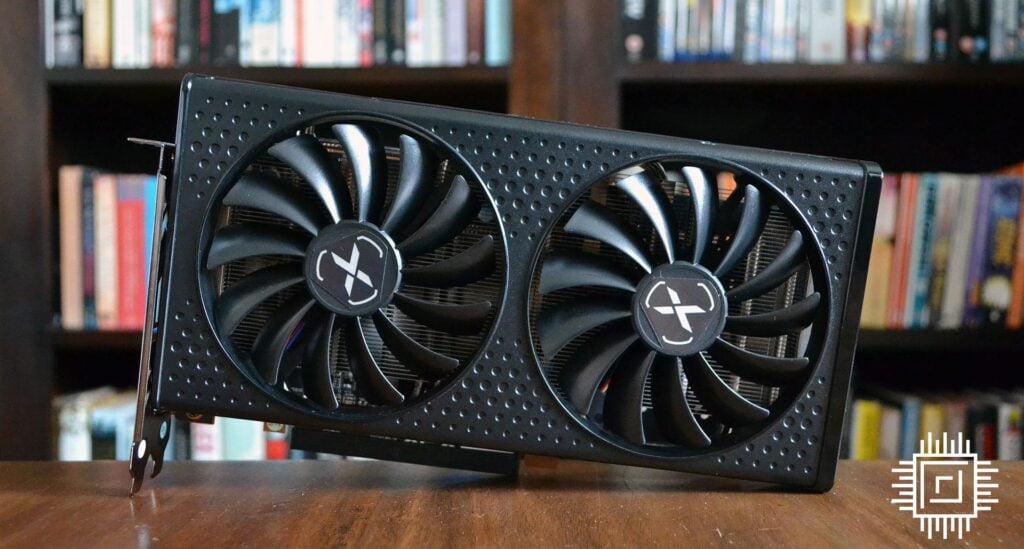
XFX Radeon RX 6500 XT Speedster Black Quicksilver 210
£179 / $199
Pros
- Super-high frequencies
- Latest RDNA 2 architecture
- Frugal on power
Cons
- 4GB framebuffer a hindrance
- Street price higher
- Only two outputs
- x4 interface sub-optimal
- Unimpressive general performance
- No video encode
Club386 may earn an affiliate commission when you purchase products through links on our site.
How we test and review products.
Now, AMD sees fit to release the most value-conscious GPUs to date, aimed at PC gamers looking to play at a 1080p resolution with cutting-edge hardware. Enter the Radeon RX 6500 XT and RX 6400.
Let’s delineate how AMD has built these sub-$200 models by rolling out the specifications and getting the fine-tooth comb out.
Club386 Table of Doom™
| GPU | RX 6600 XT | RX 6600 | RX 6500 XT | RX 6400 | RX 570 |
|---|---|---|---|---|---|
| Launch date | Aug 2021 | Oct 2021 | Jan 2022 | Jan 2022 | Apr 2017 |
| Codename | Navi 23 | Navi 23 | Navi 24 | Navi 24 | Polaris 20 |
| Architecture | RDNA 2 | RDNA 2 | RDNA 2 | RDNA 2 | GCN |
| Interface | PCIe 4.0 x8 | PCIe 4.0 x8 | PCIe 4.0 x4 | PCIe 4.0 x4 | PCIe 3.0 x16 |
| Process (nm) | 7 | 7 | 6 | 6 | 14 |
| Transistors (bn) | 11.1 | 11.1 | 5.4 | 5.4 | 5.7 |
| Die Size (mm²) | 237 | 237 | 107 | 107 | 232 |
| Processors | 2,048 | 1,792 | 1,024 | 768 | 2,048 |
| ROPs | 64 | 64 | 32 | 32 | 32 |
| Infinity Cache (MB) | 32 | 32 | 16 | 16 | – |
| Ray accelerators | 32 | 32 | 16 | 12 | – |
| Boost Clock (MHz) | 2,589 | 2,491 | 2,815 | 2,321 | 1,244 |
| Peak GFLOPs | 10,605 | 8,928 | 5,765 | 3,565 | 5,095 |
| Memory Type | GDDR6 | GDDR6 | GDDR6 | GDDR6 | GDDR5 |
| Memory Size (GB) | 8 | 8 | 4 | 4 | 4/8 |
| Memory Clock (MT/s) | 16,000 | 14,000 | 18,000 | 16,000 | 7,000 |
| Memory Width (bits) | 128 | 128 | 64 | 64 | 256 |
| Memory Bandwidth (GB/s) | 256 | 224 | 144 | 128 | 224 |
| Power Connector (pin) | 8 | 8 | 6 | 0 | 8 |
| Board Power (watts) | 160 | 132 | 107 | 53 | 150 |
| Launch MSRP (USD) | 379 | 329 | 199 | OEM | 169 |
Radeon RX 6500 XT analysis
The two new GPUs are based on a brand-new die known as Navi 24. Thanks to the use of TSMC 6nm production for the first time on desktop graphics, it measures only 107mm² and packs in 5.4bn transistors. AMD actually debuted Navi 24 on mobile at the turn of the year, and you may recognise some of the vital stats from the Radeon RX 6500M.
Back on desktop exposition, looking across to Navi 23 powering the Radeon RX 6600 XT and 6600 GPUs shows the latest RDNA 2 die to feature practically half the horsepower, which is a common theme.
There are half the number of possible processors, texture units, ROPs. Infinity Cache is also half the size, and memory bandwidth is narrowed from 128 bits to 64 – representing, you guessed it, half the capability.
AMD is acutely aware that cleaving Navi 23 into two puts the onus squarely on frequencies to ensure adequate performance. This is where the RX 6500 XT does well; it has a peak boost clock of 2,815MHz and GDDR6 memory chugging along at 18Gbps. The GPU speed represents the fastest clock on any Radeon card to date while the memory, at least in frequency, is only matched by the OEM-specific watercooled RX 6900 XT.
Hardware-assisted ray tracing is an innate part of the RDNA 2 proposal, and RX 6500 XT duly delivers by keeping to the one accelerator per CU composition delivered elsewhere across the stack. AMD cards have historically not fared as well as rival Nvidia’s for RT duties – oftentimes coming in at half the performance on price-comparable GPUs – and we wonder about the real-world practicality of using only 16 ray accelerators. AMD cannot strip them out and replace with rasterisation shader-cores without building a branched-off version of RDNA 2 bereft of ray tracing. That is just not going to happen as hardware RT support is a cornerstone of the latest AMD graphics architecture spanning PC and console.
“AMD is acutely aware that cleaving Navi 23 into two puts the onus squarely on frequencies”
Peering further down, there isn’t a whole heap of memory bandwidth available to the card when evaluated in the traditional sense. 144GB/s is anaemic for a $199 offering, though AMD counters by insisting the Infinity Cache – a pool of fast memory residing between the compute engines and main card VRAM – helps boost real-world bandwidth.
Infinity Cache bandwidth is calculated by understanding the fabric clock operates at 1.8GHz and on four channels concurrently. Each channel provides 64-byte transfers per clock, so adding it all up – 1,800MHz x 4 x 64 – reveals 460.8GB/s bandwidth. This is 3.2x faster than card memory, though the downside is IF’s capacity is limited to merely 16MB, rendering it largely ineffective at higher resolutions and image-quality settings.
4GB surely an Achilles heel in 2022
It’s clear that AMD has primed the GPU to be rather profitable at the $199 retail price tag, and one undesirable knock-on effect is it will only feature 4GB of video memory. To be clear, there is no current option for an 8GB framebuffer. Other than savings in cost, part of the reason may lie in dissuading Ethereum miners from pillaging stock; the DAG file already exceeds 4GB and thus any mining becomes increasingly inefficient as time goes on.
4GB may well be enough to load the necessary high-resolution textures at a FHD resolution but will cause issues at, say, QHD. Rival Nvidia is opting for 8GB on the entry-level desktop RTX 3050, albeit that GPU is set to cost $50 more.
“To be clear, there is no current option for a 8GB framebuffer”
The allocated memory pool will certainly struggle as textures and associated loads exceed its ability to hold them. In these instances the GPU will trace a route back to main system memory, which is an order of magnitude slower, thus hampering performance drastically.
Do note that all Radeon RX 6500 XT cards feature a PCIe 4.0 x4 electrical connector, not x8 as on the RX 6600 XT and x16 for the premium stack. This is no major problem if you’re rocking a modern motherboard, but anyone plugging this card into an older chipset will be limited to PCIe 3.0 x4, which isn’t great for optimal performance – particularly if, as noted above, texture transfers need to traverse the PCIe bus. We will examine this 4GB framebuffer and potential PCIe 3.0 x4 bottleneck in the performance section.
We have included the Radeon RX 570 in the above table as it offers a good frame of reference from a GPU that is almost five years old. Launched from $169 in April 2017, an on-paper comparison doesn’t bask the new RX 6500 XT in a refulgent light – there’s a broadly similar amount of GFLOPs throughput and traditional memory bandwidth is down. Of course, architecture refinements and feature advances for RDNA 2 vs. GCN aren’t exposed in the Table of Doom™, but we still don’t expect the RX 6500 XT to be much faster in typical rasterisation-only titles.
Approaching this launch holistically, AMD wants a sub-$200 desktop graphics card based on the latest RDNA 2 architecture. For better or worse, the Radeon RX 6500 XT 4GB is it, and many of the potential pitfalls emanate from it being a mobile-first GPU. Reading between the lines, moving this interpretation over to desktop may have been a last-minute decision. Whatever the true provenance, let’s take a closer look at a partner card before we run the benchmarks.
The XFX Radeon RX 6500 XT Speedster Black Quicksilver 210
Radeon RX 6500 XT cards that make most sense to us need to be relatively small, shorn of superfluous extras that inflate price, and offer a modest overclock. Looking to hit all these straps is the XFX Quicksilver 210.
Understanding the meagre board power starting at 107W for the RX 6500 XT begs the question why any card needs to be large. The Quicksilver 210 isn’t huge; it measures 230mm long, 130mm tall and 40mm thick, but could be made smaller; we have already seen Radeon RX 6600 cards occupy a more diminutive mini-ITX form factor.
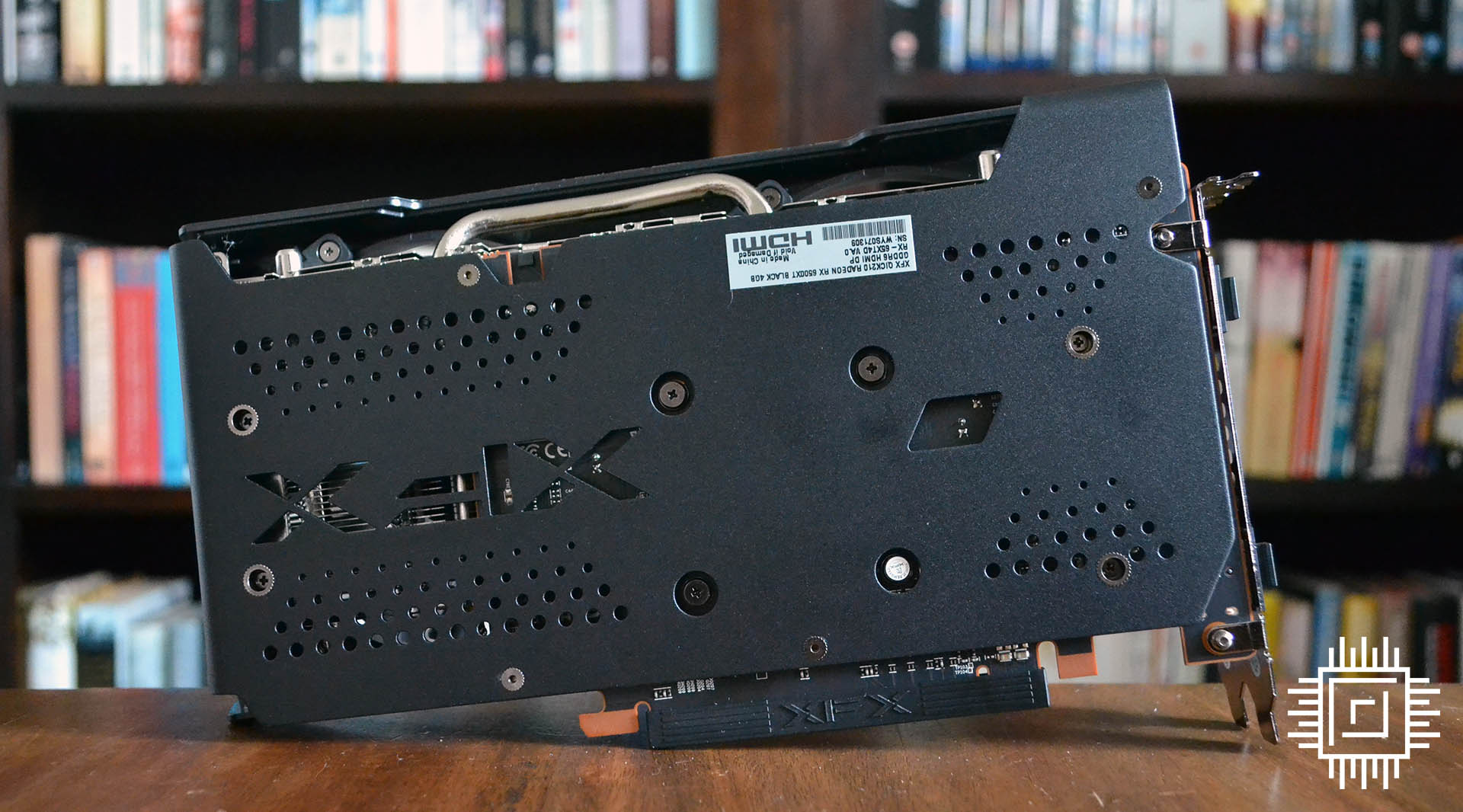
Weighing in at 600g means XFX hasn’t gone for an overly bulky heatsink-and-fan assembly. Fit and finish is good, while clean aesthetics are helped by a neutral colour scheme and a total absence of RGB. The twin 95mm fans switch off at low loads and actuate through a gradual, predictable increase in RPM. We observed no noticeable coil whine.
There’s little reason for a rear backplate other than to provide a means by which to secure the heatsink in place. XFX uses the extra real estate over and above the rear PCI bracket to house the heatpipes jutting out of the block.
Cooling assembly is straightforward and on closer inspection it’s good to see XFX adding thermal pads to the two memory chips and power stages.
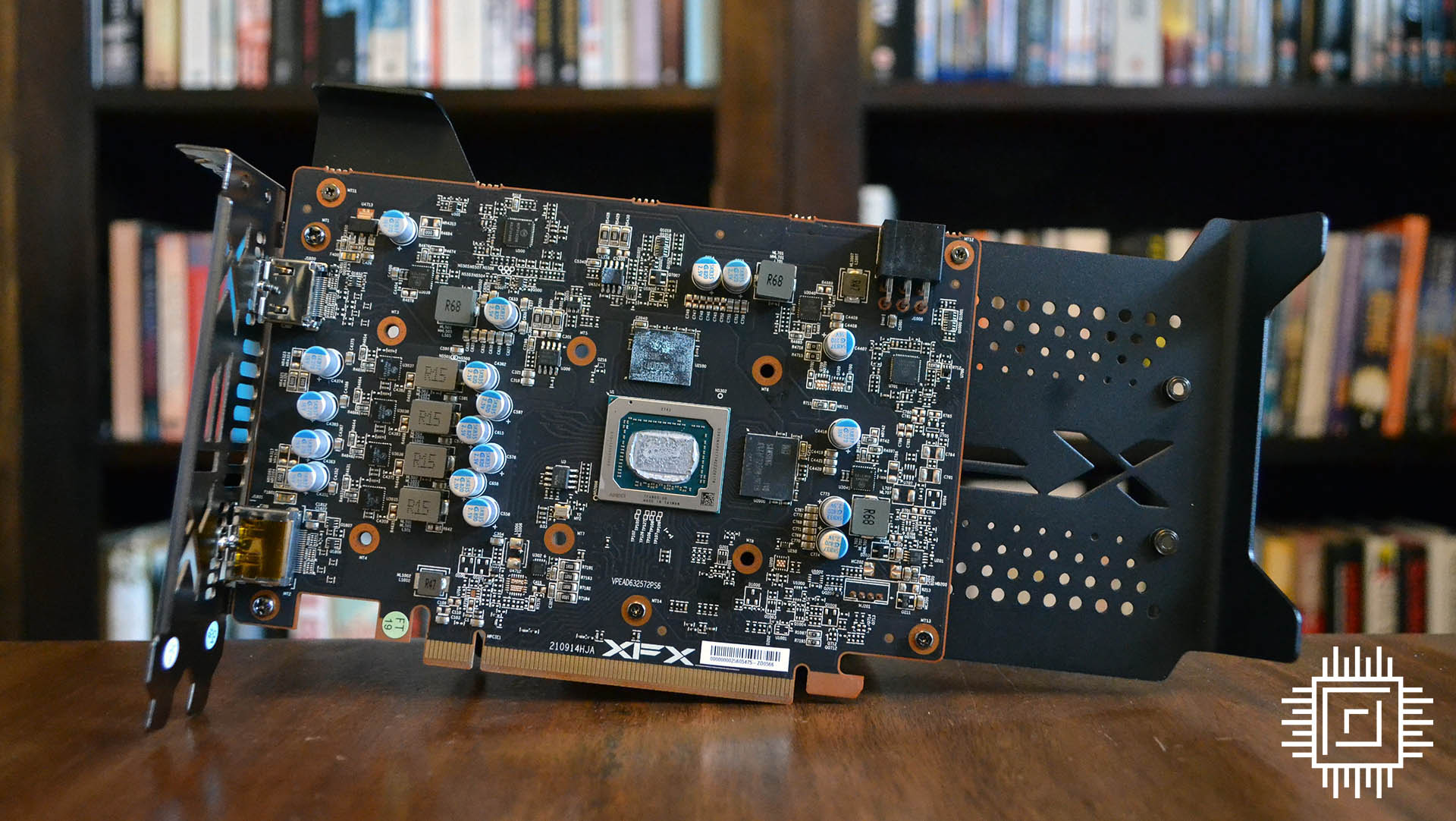
Numbers often don’t paint the appropriate picture. Looking at the tiny Navi 24 die above, the 107mm² piece of silicon really is tiny, to the extent it looks out of place on a 160mm-long PCB, and is arguably smaller than the GDDR6 memory chip. Regarding the latter, Samsung is the go-to provider for 18Gbps VRAM.
Should AMD ever mandate it, adding an extra 4GB of memory is a straightforward affair, though XFX’s PCB would need minor modification to double the number of ICs, on the assumption the company uses the same density of Samsung chips.
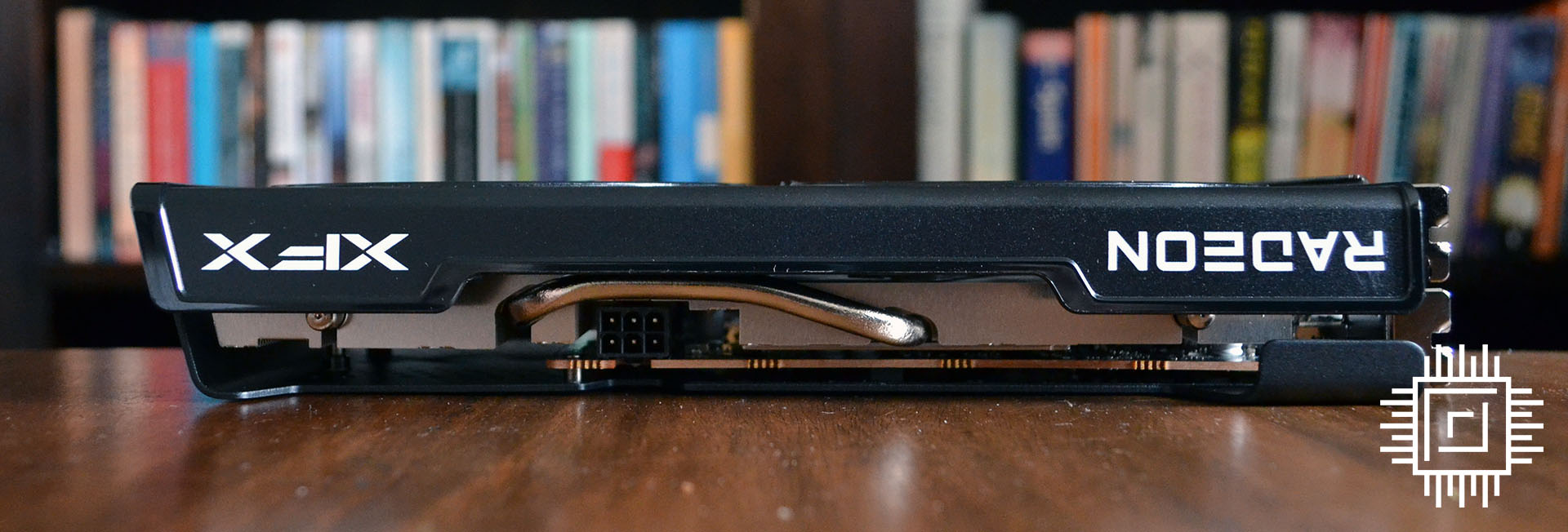
Knowing the power restraint in force with Navi 24, XFX uses a 6-pin PSU connector that’s actually at the very tip of the PCB; the remaining area to the left is for heatsink overhang alone. It’s absolutely conceivable a mini-ITX card is possible, and indeed desirable, but even so, we have no qualms in how XFX has gone about cooling.
Stated frequencies mean little when boost clocks predicate performance. Logs show the XFX ran at an average 2,855MHz when under the pump, which is the fastest we have seen on any graphics card. Memory chugs along at the recommended 18Gbps.
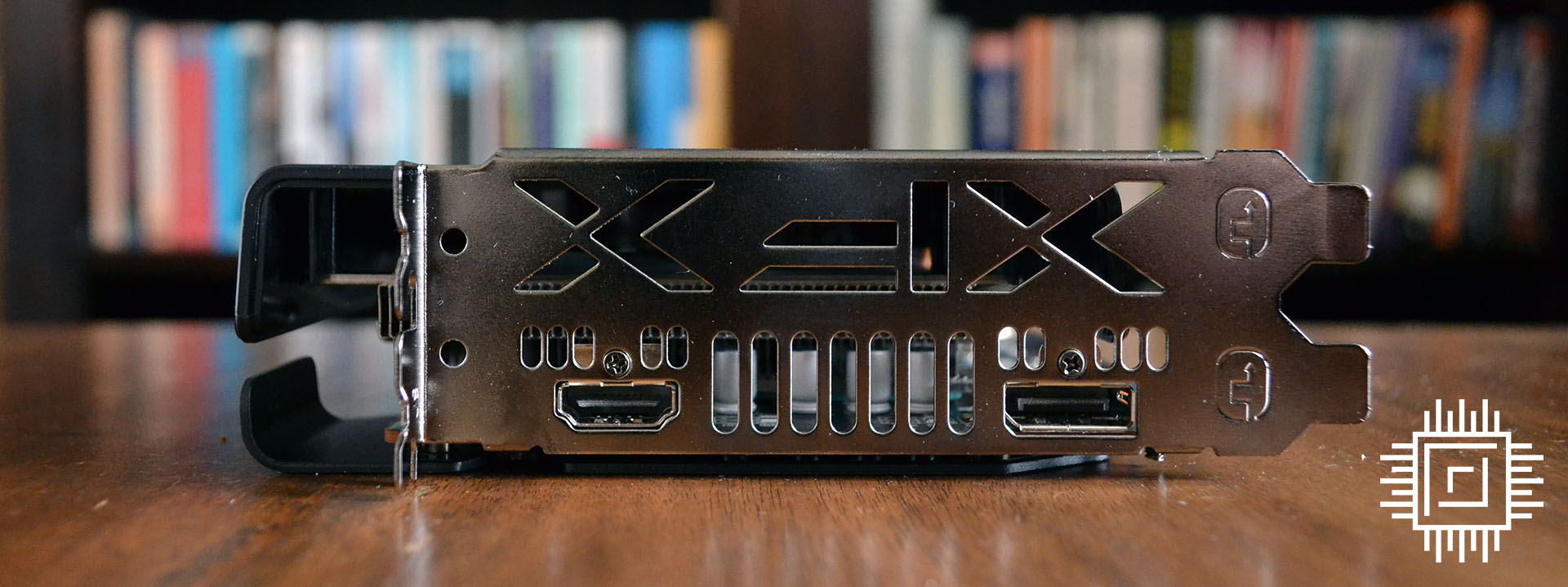
It would normally be reasonable to assume XFX is skimping on the rear outputs by only having two. That line of thinking is wrong because AMD hamstrings the video side of the card by limiting support to what you see above.
Furthermore, the Navi 24 GPUs don’t have a hardware encode block at all, limiting their streaming potential, and AMD argues the modest performance doesn’t warrant extra expenditure for encoding. Decode is taken care of for VP9, H.264 and H.265; AV1 is missing and may deter home cinema buffs from adopting RX 6500 XT.
Performance
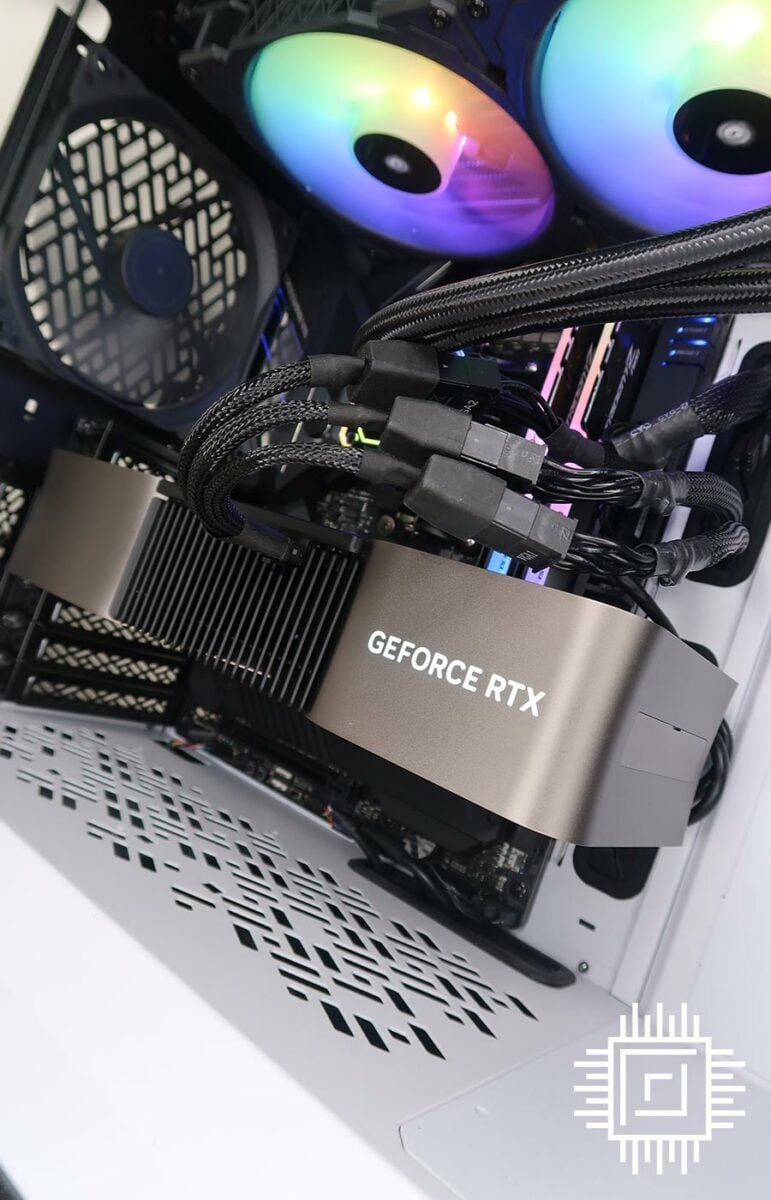
Our 5950X Test PCs
Club386 carefully chooses each component in a test bench to best suit the review at hand. When you view our benchmarks, you’re not just getting an opinion, but the results of rigorous testing carried out using hardware we trust.
Shop Club386 test platform components:
CPU: AMD Ryzen 9 5950X
Motherboard: Asus ROG X570 Crosshair VIII Formula
Cooler: Corsair Hydro Series H150i Pro RGB
Memory: 32GB G.Skill Trident Z Neo DDR4
Storage: 2TB Corsair MP600 SSD
PSU: be quiet! Straight Power 11 Platinum 1300W
Chassis: Fractal Design Define 7 Clear TG
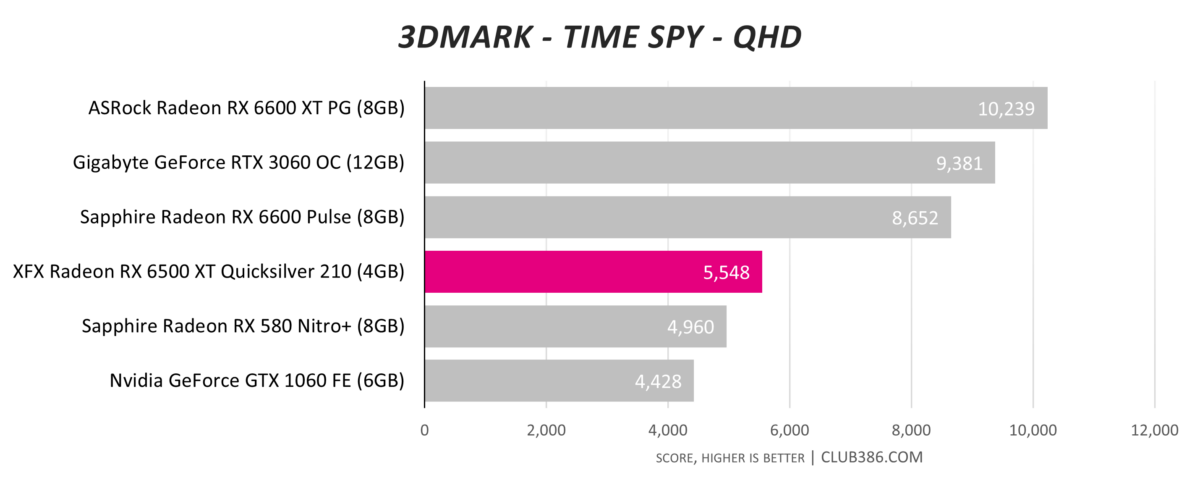
The first test immediately shines a light on Radeon RX 6500 XT performance. Having approximately half the capability of the RX 6600 XT is in evidence; the XFX card manages just 54 per cent of the larger Navi’s performance.
In fact, it’s not correct to measure its gaming ability against, say, the RX 6600 XT and RTX 3060 OC because they belong to a different class. RX 6500 XT is closer in performance to the much older Radeon RX 580 and GeForce GTX 1060.
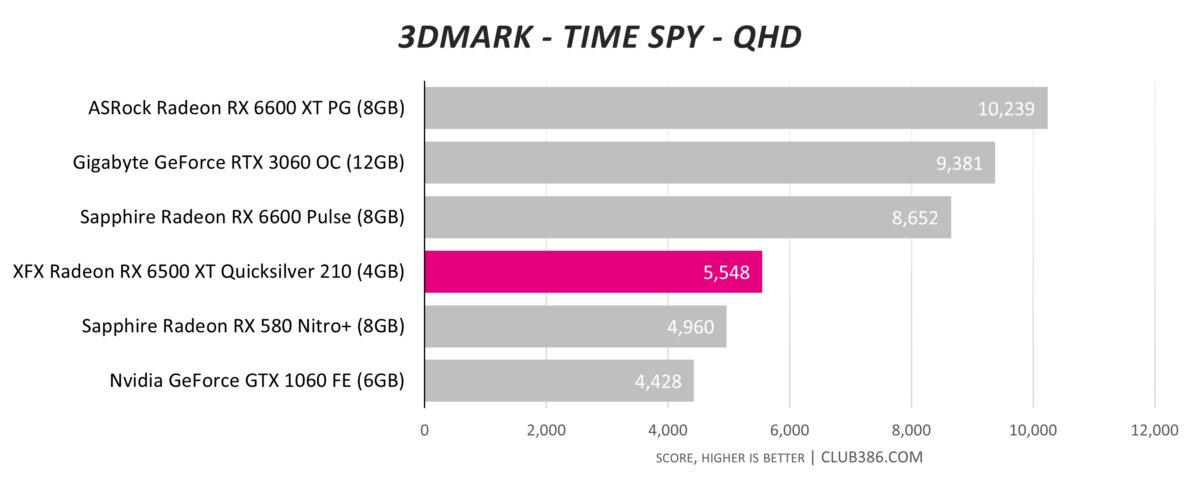
More of an academic test for a card of this ilk, it struggles to keep ahead of an RX 580 released in 2017 and isn’t a whole heap faster than the GTX 1060 of 2016.
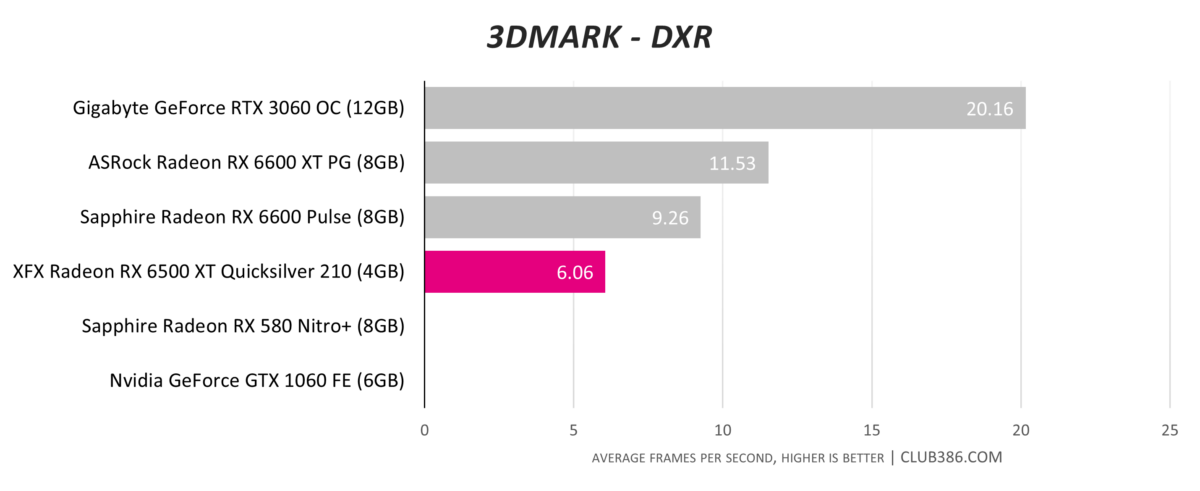
Only very modern cards can complete the hardware ray tracing test. AMD has lagged behind Nvidia on this front for a while, so we don’t expect the latest Navi to mix it up against the RTX 3060. The more interesting comparison is against the upcoming RTX 3050.
Taken in context, ray tracing performance is more of a footnote than keen selling feature.
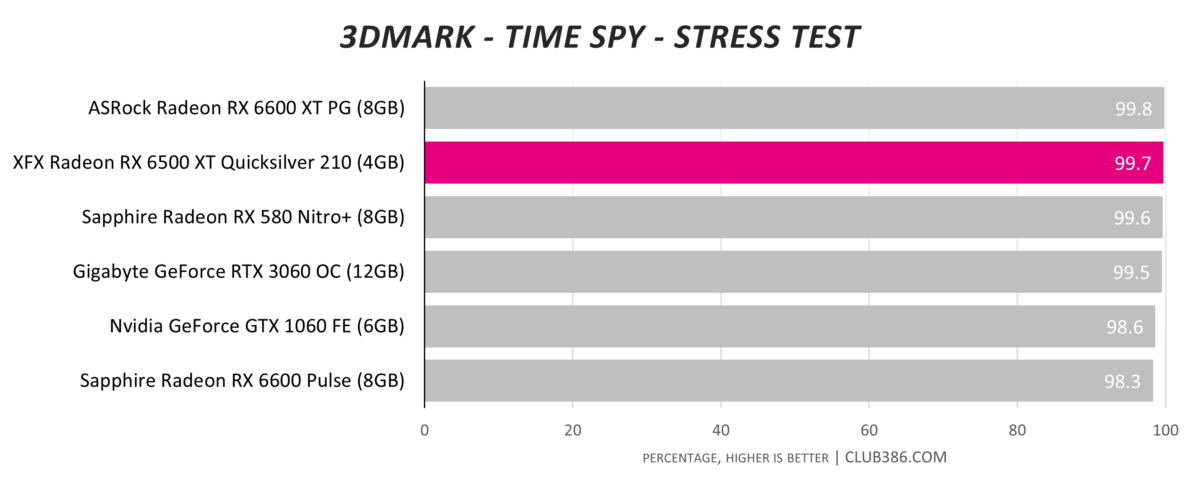
Nothing wrong with XFX’s cooler, just as we suspected.
Assassin’s Creed Valhalla
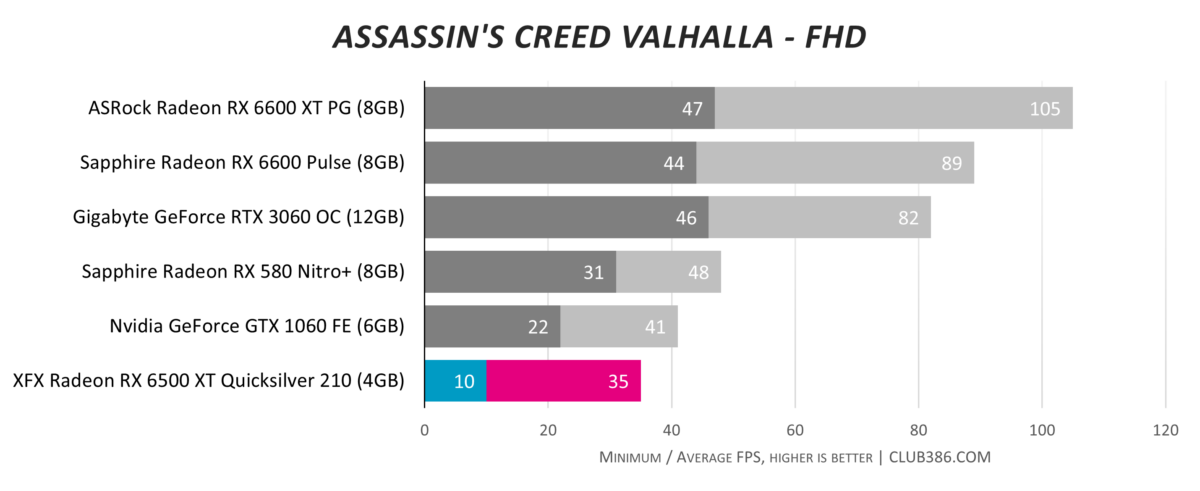
Here is where we see the first indication of sub-par performance emanating from a 4GB framebuffer. Thinking about it logically, games with little texture load, or if set to lower image-quality settings, will happily run on a 4GB memory pool without undue loss of performance.
Assassin’s Creed Valhalla isn’t one of those titles, particularly at our tested settings of Very High Quality. We chose to run it as the RX 6600 XT 8GB is able to surpass 100fps with this configuration, but alas, RX 6500 XT struggles. The game reports a 5,036MB VRAM uptake, thus swamping the framebuffer and making the card cycle back over the PCIe bus to load textures from memory – more on that later.
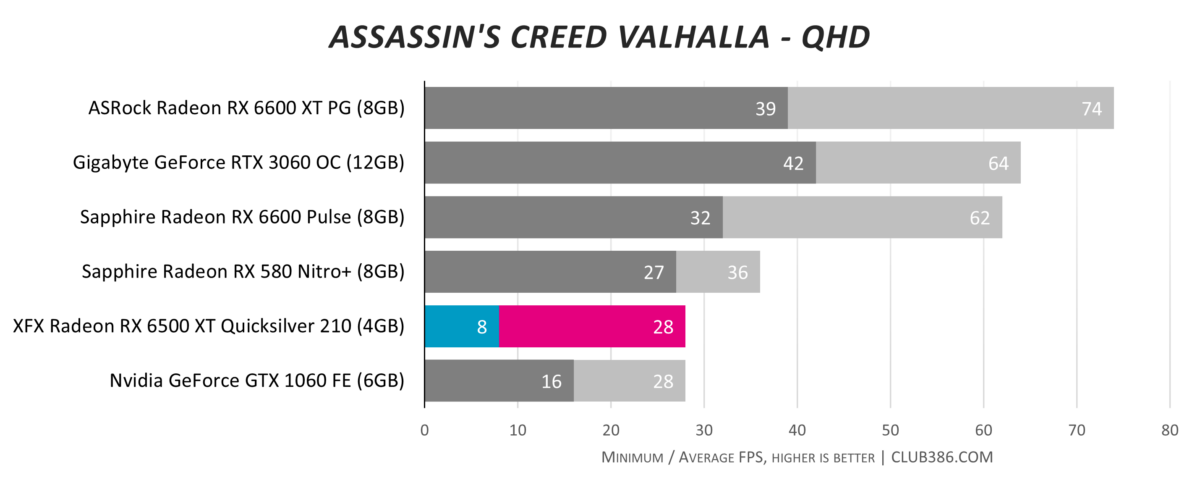
If FHD was problematic then issues mount further at QHD. The combination of small framebuffer and limited PCIe bus traversal combine to ensure the next GPU up, RX 6600 8GB, is more than twice as fast.
It’s telling this card is no quicker than a five-year-old GTX 1060 6GB.
Far Cry 6
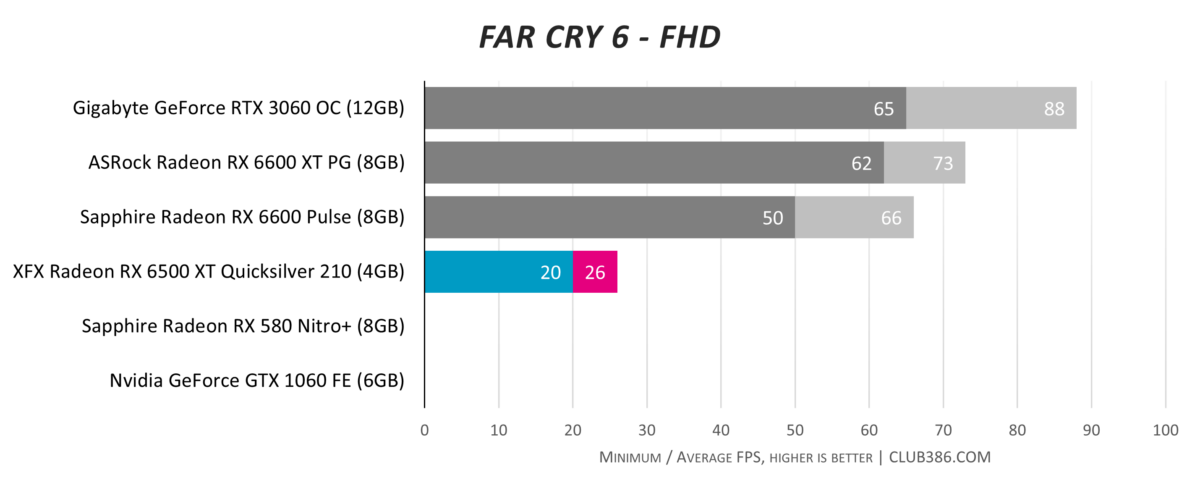
Piling on the hurt is Far Cry 6. We run with ray tracing in situ, which automatically puts the Radeons on the back foot and serves to eliminate RX 580 and GTX 1060.
The low average framerate results from a combination of being inefficient at ray tracing and that pesky 4GB framebuffer.
AMD will doubtless counter that RX 6500 XT is not primed for FHD gameplay with ray tracing invoked, particularly for triple-A games, but our retort is that we lower quality settings to merely High for all mainstream cards. That and the RX 6600 able to mete out in excess of 60fps.
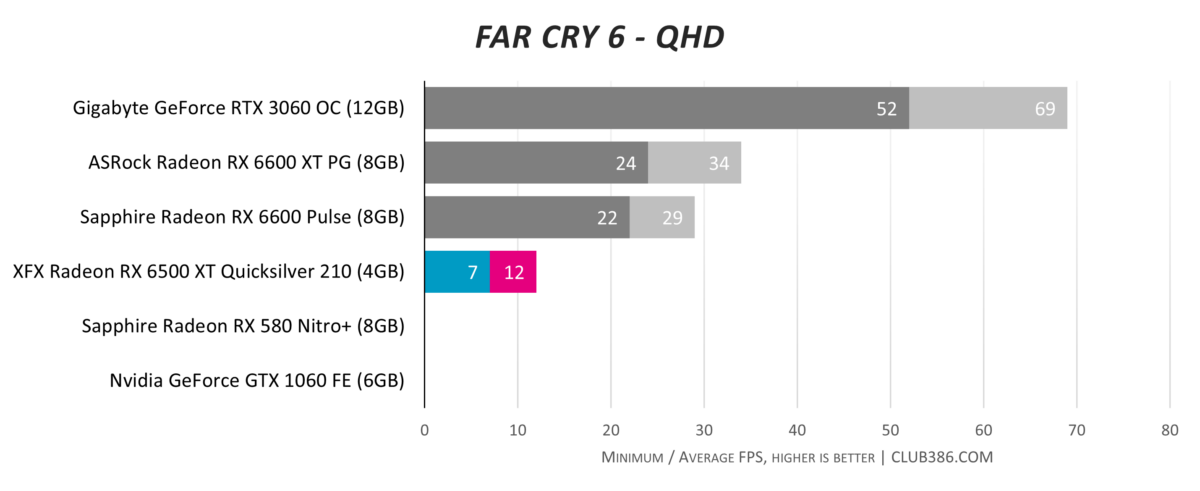
We can almost feel the card squeal under QHD RT load. No amount of FSR is going to help in this instance.
Final Fantasy XIV: Endwalker
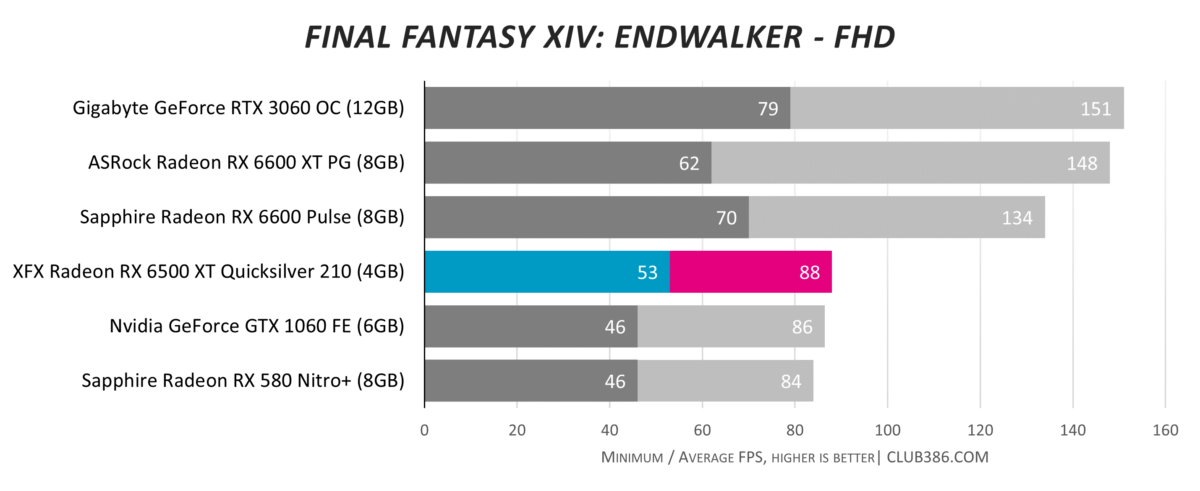
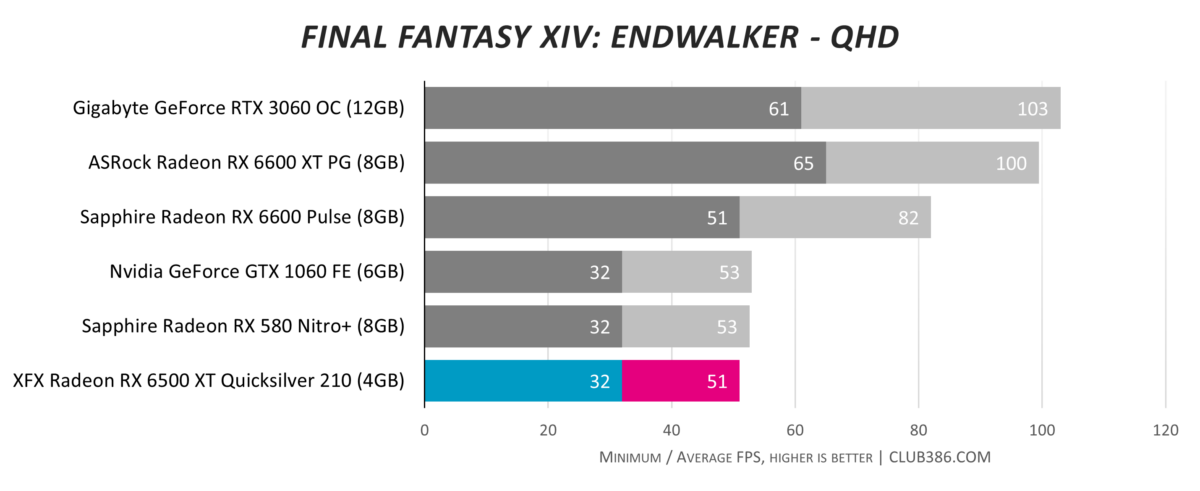
There remain titles that are based on older engines and are wildly popular. Final Fantasy: Endwalker is one such game, and it produces healthy framerates at FHD and passable rendering at QHD.
That said, the RX 6500 XT is no faster than a GTX 1060 from yesteryear.
Forza Horizon 4
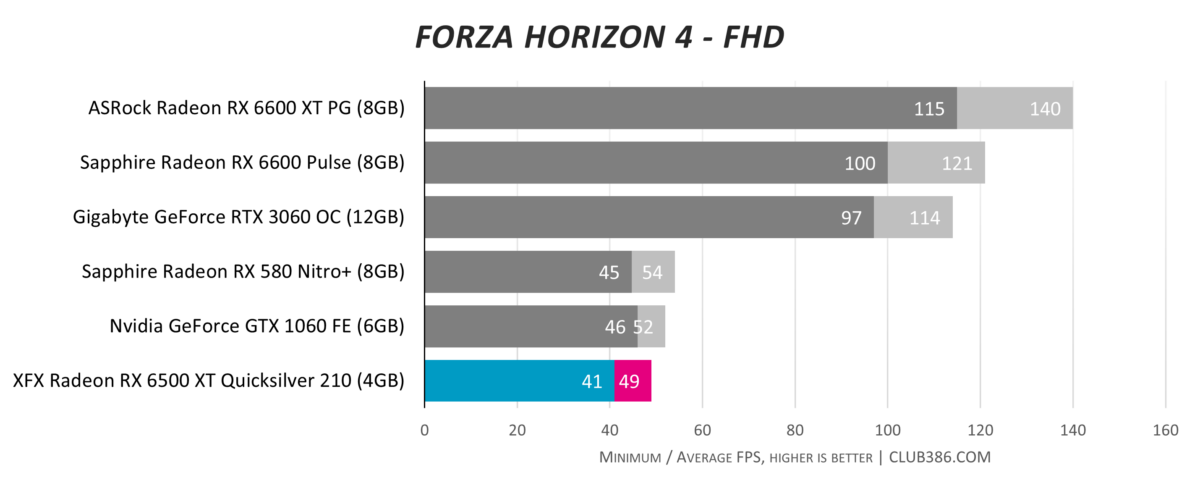
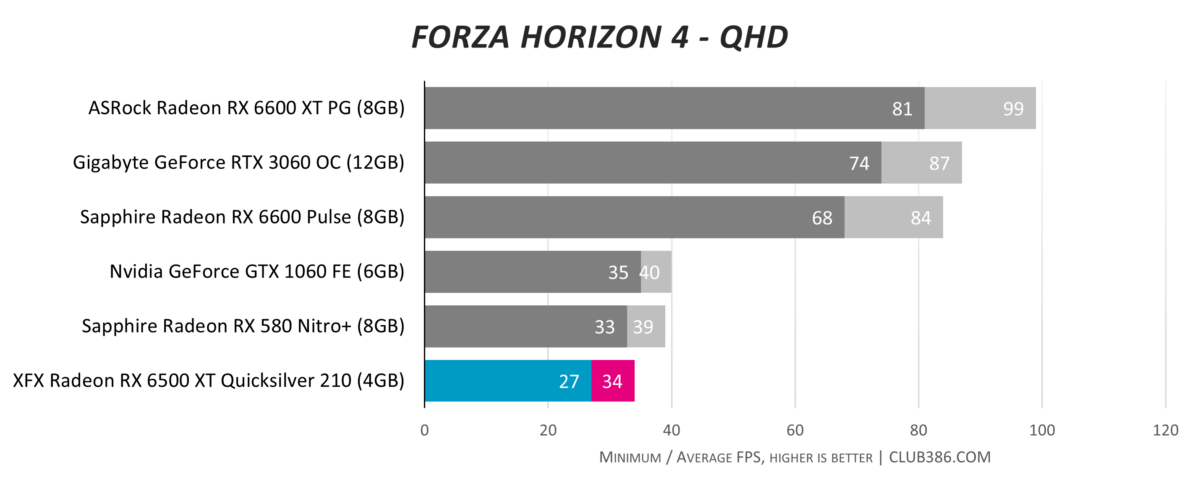
Our testing reveals the weak points of the Navi 24 architecture. They are numerous, too, as an innate lack of rendering muscle is one, anaemic RT performance another, and having only 4GB of onboard memory a third.
Put simply, you need to carefully tone down the image-quality settings and resolution in order not to trip the card up.
Gears Tactics
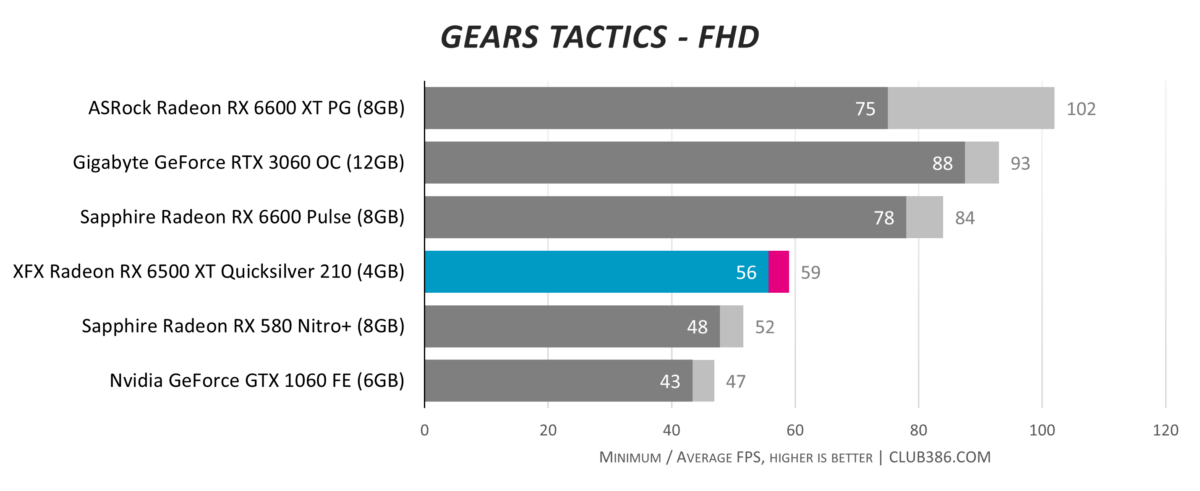
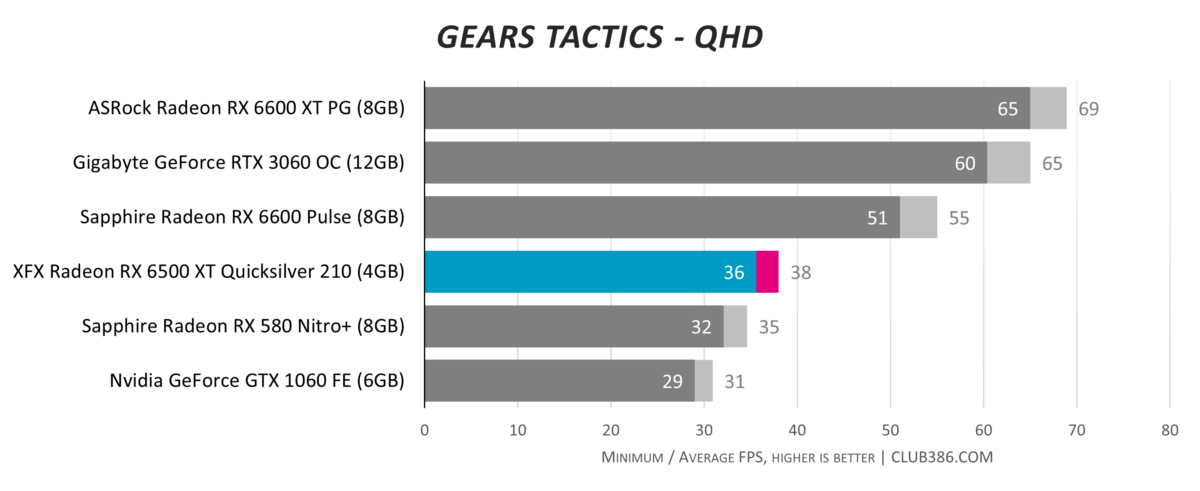
Better performance here, but that’s because Gears Tactics is such a well-tuned game.
Vitals
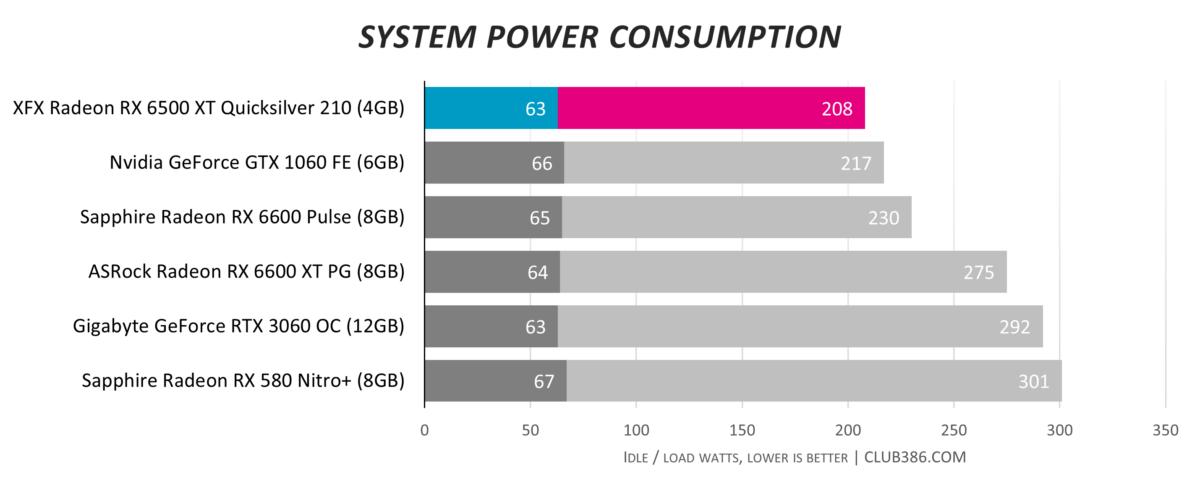
6nm production and a tiny die operating at sky-high frequencies still leads to the lowest system-wide power consumption in our test. A predictable win for RX 6500 XT.
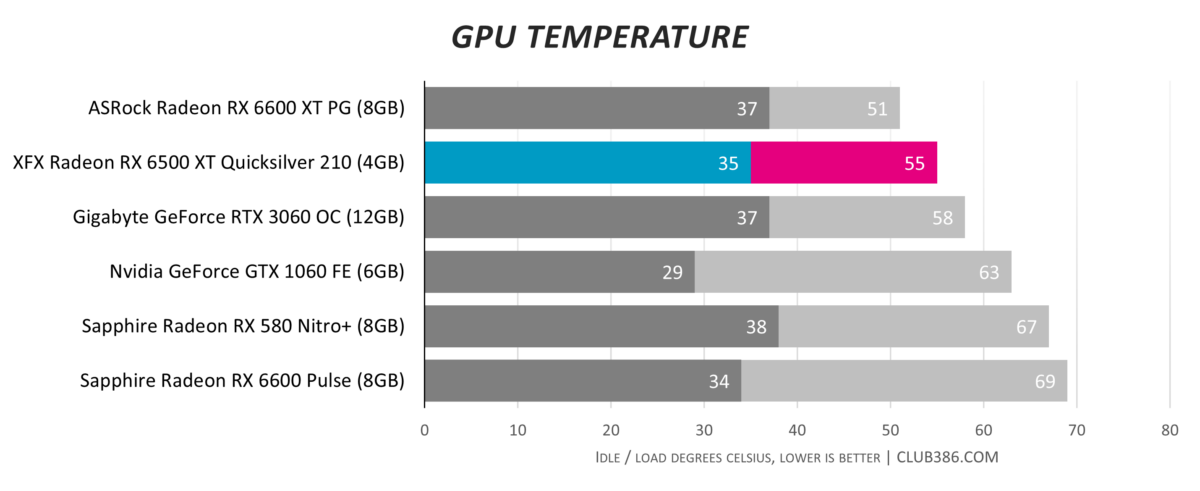
And that tiny die doesn’t bother the XFX cooler. The two fans barely get up and running even under the most stringent of load.
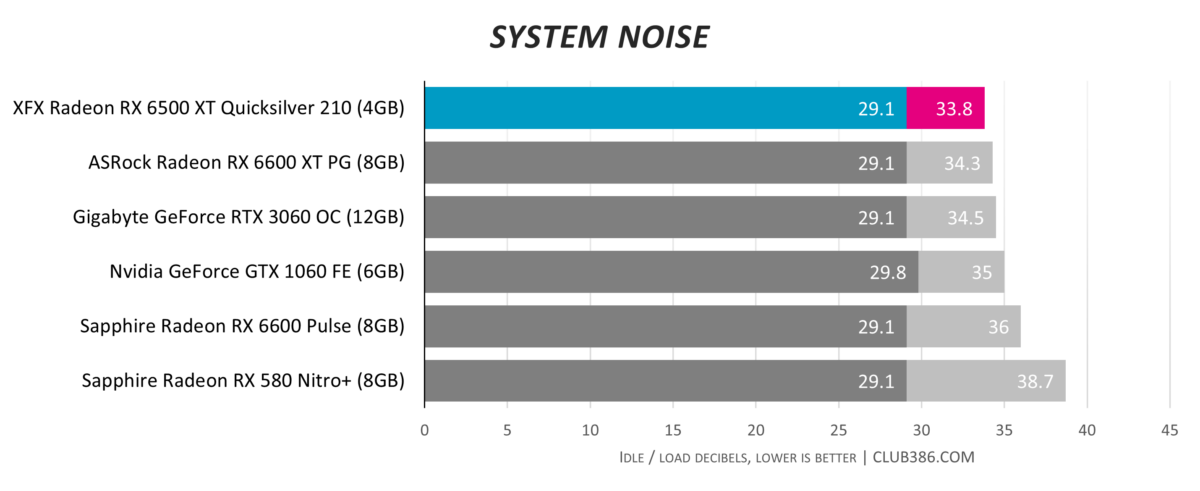
Rounding out an impressive section for XFX/AMD, the Quicksilver 210 is very quiet to boot.
For those wondering about overclocking, our sample wouldn’t respond to higher frequencies. Installing a minor overclock led to a small reduction in fps, intimating AMD is running close to the MHz wires.
PCIe 4.0 x4 vs PCIe 3.0 x4 investigation
We made mention earlier in the editorial that the x4 interface could cause problems in millions of older systems whose motherboards only accept a PCIe 3.0 conduit.
Running the RX 6500 XT in one of those boards reduces unidirectional bandwidth to 4GB/s. This isn’t a huge problem when the graphics card has lots of onboard memory to buffer operations – we’re thinking 8GB+ here – but the constant in-and-out loading of textures and other assets affects 4GB to a larger degree.
It is only prudent we examine how the RX 6500 XT behaves when in a PCIe 3.0 x4 environment that many will have to run it in. We do this by manually switching our PCIe 4.0-capable Asus X570 Crosshair VIII Formula into PCIe 3.0 mode via the BIOS.
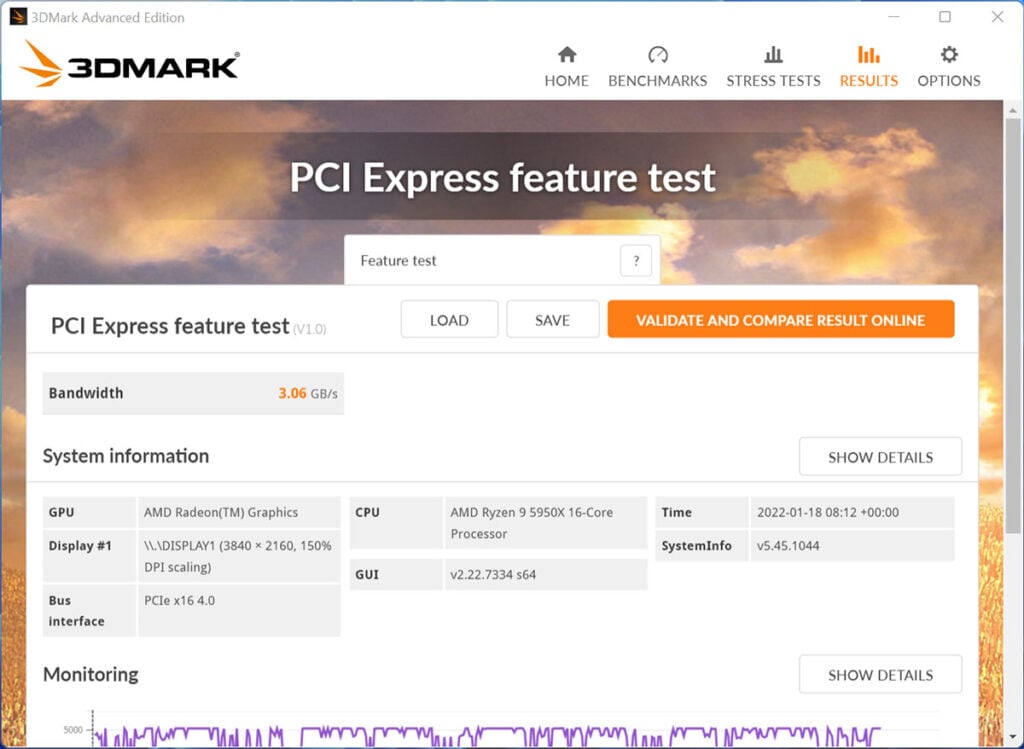
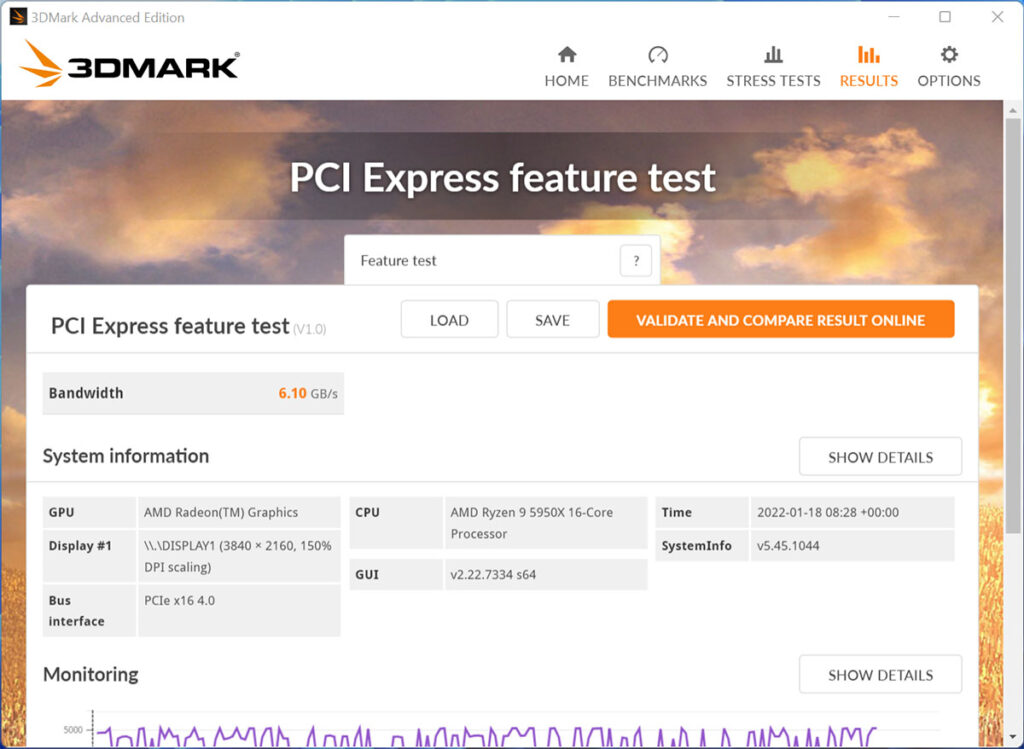
We know it works because the PCI Express Feature test reports half the bandwidth when manually toggling the interface protocol.
Remember all that’s changed is the interface speed, dropping from the native PCIe 4.0 x4 for our test system to PCIe 3.0 x4. Games which rely on lots of texture moves and already swamp the 4GB framebuffer at our chosen settings are most sensitive to a drop in transfer bandwidth.

Assassin’s Creed Valhalla is no fan of PCIe 3.0 x4 and a 4GB VRAM store.

Adding ray tracing into the mix introduces even more complexity that the meagre onboard memory and lower transfer bandwidth cannot handle. We’re looking at practically half the native performance here, which is already considered low.

Games that run on older engines and don’t exact a huge framebuffer toll are largely oblivious to half the card-to-system bandwidth. Makes sense when you think about it.

Forza at maximum settings likes to have a fast interface… that or at least 8GB of memory.

Last but not least, Gears Tactics runs well no matter how much we gimp the RX 6500 XT.
Conclusion
Built on a brand-new Navi 24 die measuring a scant 107mm² and the first desktop card to use 6nm production, the Radeon RX 6500 XT aims to entice gamers into the RDNA 2 ecosystem by offering a forward-looking feature set and sub-$200 pricing.
“RX 6500 XT would be better served by having an 8GB option alongside a PCIe 4.0 x8 interface”
Primed for 1080p gaming, RX 6500 XT has about half the innate horsepower of last year’s RX 6600 XT. That’s no major obstacle if weak spots aren’t present, but sadly for this GPU, specifications only get you so far.
AMD’s decision to restrict the card to 4GB, with no immediate option for 8GB, cruelly hampers real-world gaming potential. Compounding matters is a x4 interface that’s fine on the latest motherboards but one that, according to our testing, causes slowdowns on well-established boards only capable of PCIe 3.0.
Rasterisation performance no better than age-old RX 580 8GB and GTX 1060 6GB and ray tracing chops not worth writing home about are impossible to ignore.
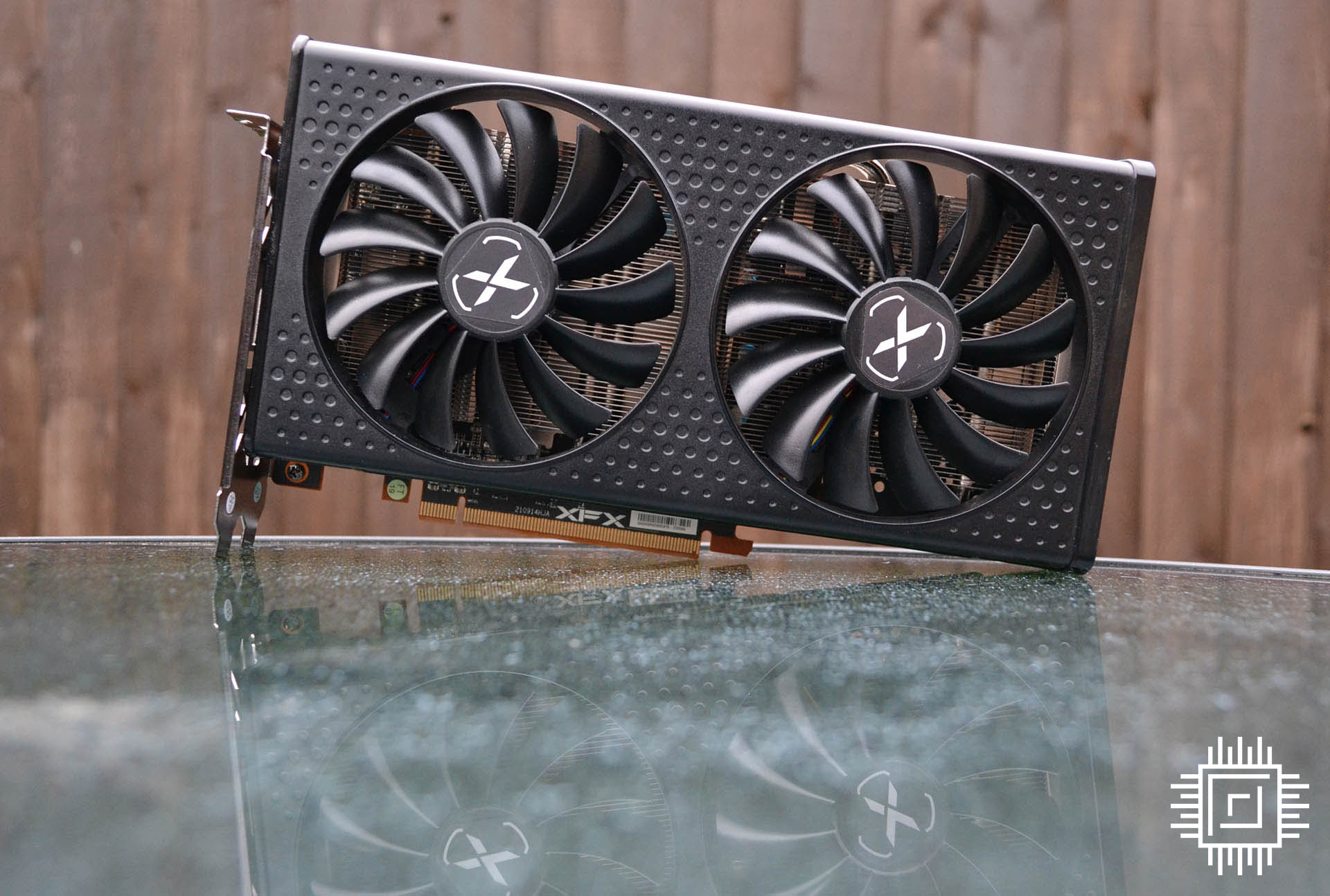
The RDNA 2 architecture’s potency is diluted by the savage cuts visited on this GPU, and RX 6500 XT would be better served by having an 8GB option alongside a PCIe 4.0 x8 interface, thus keeping performance bottlenecks more at bay. Technologies such as FSR can help in ameliorating performance missteps, but even they can only go so far.
All this talk about the RX 6500 XT’s foibles matter less if it’s priced aggressively. Set to $150 and our technology implementation misgivings begin to recede, but at $199 and with due account of the performance level, it is fair to question how AMD has gone about building the GPU.
Ongoing stock constraints won’t help matters; we expect to see few RX 6500 XT cards available at even $199 (£179), so as much as we welcome new GPUs into the PC gaming universe, the RX 6500 XT is the weakest of the bunch. Acceptable to the casual gamer who wants the next step up from integrated graphics or an entry-level card from years ago, we’d recommend triple-A title hunters look elsewhere.
Verdict: Whittled in design and hamstrung by curious choices of 4GB VRAM and a x4 interface, RX 6500 XT faces an uphill task.

